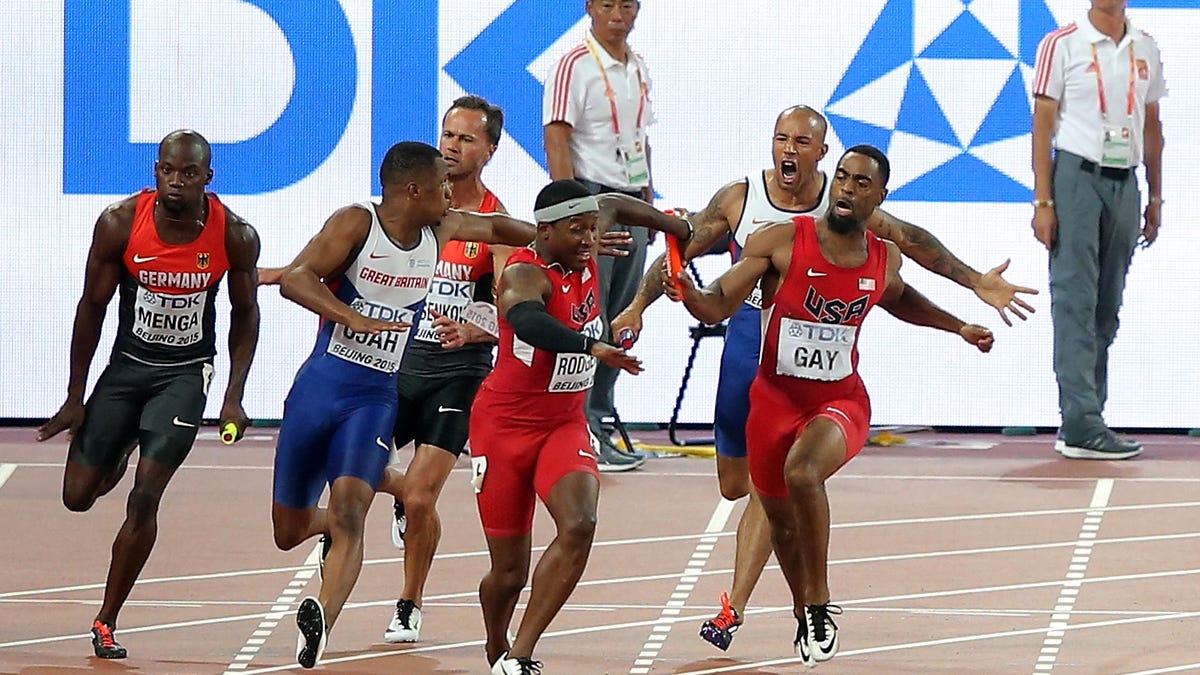US Olympic track star out to prove Halo Sport headphones make him faster, stronger
Can headphones designed to improve focus help track stars shave milliseconds from their times? One US Olympic sprinter thinks so.

Olympic sprinter Mike Rodgers is hoping a pair of high-end headphones will help him win gold.
He and a handful of other US track stars have been training with Halo Sport headphones, which shoot electrical impulses into their brains to create more synchronous connections between neurons and muscles. Those connections, he says, might be enough to give him the slightest of edges -- a millisecond or so -- at the Summer Games, which open in Rio de Janeiro on Friday.
"I like what it's doing to my body right now," Rodgers said of the shiny black headset. Rodgers, a member of the 2015 world champion 4x100-meter relay team, has been training around the world with Halo for the past month.
Athletes have been using wearable devices to improve their performance and apps to measure their technique for years. Halo headphones are the latest twist, an attempt to influence physical performance by stimulating the brain. The concept: A stronger brain equals a stronger body.
Halo uses a technology known as tDCS -- transcranial direct current stimulation -- to shoot electrical currents through the brain. The headphones' foam spikes act as electrodes to speed up the neurons to the brain's motor cortex, a practice called "neuropriming."
Neuropriming can improve an athlete's strength, explosiveness and dexterity during workouts, Halo says.
Chao, a medical doctor, and Brett Wingeier, a biomedical engineer, founded Halo Neuroscience in 2013. The pair previously were part of the creative team behind NeuroPace, a device to treat epileptic seizures that was approved by the Food and Drug Administration in 2014.
Backers and experimenters
In its short life, Halo has attracted big-name investors, including venture capitalist Marc Andreessen of Andreessen Horowitz. Reed Hundt, a former chair of the Federal Communications Commission, and Susan Paley, former chief executive of the Apple-owned Beats, are advisers to the company. (The Halo headset bears more than a passing resemblance to Beats' popular design.)
The US ski team uses Halo, as do a host of MLB, NFL and NBA teams, Chao said. The 2015 NBA champion Golden State Warriors, for example, spent this past record-breaking season piloting the headphones.
"We're looking into every advantage we can to make us a better team," Daniel Brusilovsky, who leads the Warriors' digital initiatives, said earlier this year. That edge to get one more win, is critical, he added.
Halo isn't the only product designed to improve performance by targeting the brain. There's the Fisher-Wallace Stimulator, which treats anxiety, depression and insomnia, and foc.us v2, which also uses tDCS but is specialized more for video gamers.
It's an open question how effective devices like Halo are. Not enough data exists to confirm any performance boosts are caused by the device. Some brain scientists say it could simply be a placebo effect, an improvement caused by belief the device is helping.
"Brain stimulation is not a one size fits all," said Ted Zanto, a neuroscientist at the University of California, San Francisco, who says more research is needed to measure the effect of tDCS on the brain. "I don't know if this will make an athlete incrementally better or worse."
Chao says he gets the skepticism.
"We understand that we're creating a new category and it's going to take a lot of education," he said. "We're game."
We try Halo for ourselves
And so was I, along with my colleagues Lexy Savvides and Josh Miller. We headed to Halo's headquarters for a couple of demonstrations.
Within seconds of putting the $649 headset on, I could feel a tingling sensation on my frontal lobes. It morphed a pulsating, rhythmic waves that made me move my head -- a lot. I had the device set at 8 (10 is the highest). Josh, a photographer, began snapping shots as I felt more focused, even chattier.
Chao smiled. Josh laughed.
On a a separate visit, Lexy measured her grip strength while wearing the headphones. The technicians concluded her strength had increased by 9 percent.
"I felt like I was becoming more alert to my surroundings," Lexy said. "I felt as if my speech sped up a little bit. I felt like I had more clarity of thought."
And that potential to improve his focus and performance fascinates Rodgers. The Olympic sprinter (and Usain Bolt rival) will be competing on the US men's 4x100 relay team in two weeks, has been using the Halo headphones for more than a month. He plans to wear the headphones during warmups, in between races and in the weight room in Rio.
Initially, Rodgers was skeptical about using the device. "Uhh, I don't know if I want electric currents going through my brain," he recalled thinking. He also tried it at level 10.
Too strong.
"I actually thought my hair was falling out. I started sweating profusely," said Rodgers, who eventually settled on level 8 before inching up to 10.

